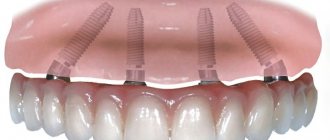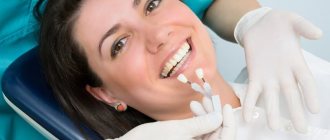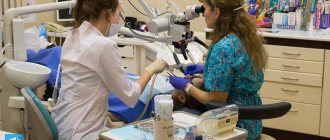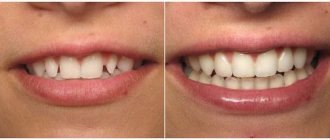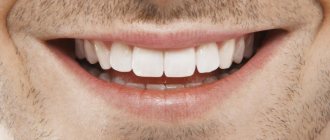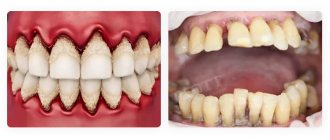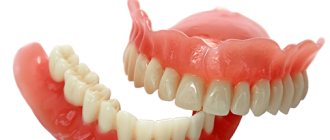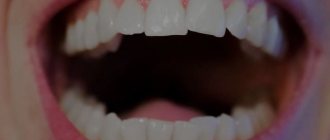A beautiful smile undoubtedly matters to a person. After all, this is what many people fix their attention on when they meet. A smile leaves an unforgettable impression on the interlocutor. It plays an important role in your confidence when communicating. A beautiful smile will improve contact with your interlocutor, improve behavior and leave behind all sorrows and self-doubt, and will also melt the heart of any stranger. But if the smile is not perfect and there is a defect in the front teeth (cracked dental plate, extracted tooth, crooked bite or tooth fragment, caries), how can we talk about self-confidence? Such a person will become isolated from others, become withdrawn, stop smiling, and will feel awkward when communicating. All this can leave a mark on a person’s profession and on his personal life.
No one wants to show problems with their front teeth to others, so dentures are the best solution for such patients.
When performing prosthetics after removal, it is important to restore and preserve the functions of the organ:
- Correct bite;
- Shape;
- Natural color;
- Gum health.
Prosthetics of the front teeth is also an aesthetic issue, therefore, to create a beautiful smile, it is necessary to use high-quality, durable materials that will visually look good. In dentistry, several methods of installing dentures are used and leading materials are used to give each patient a dazzling smile.
The main indications for the use of anterior dental prostheses are:
- Cracks in the dental plate, chips, broken teeth;
- Lost teeth or congenital adentia;
- Carious teeth;
- Crooked bite;
- Yellowing or darkening of the enamel;
- Crooked teeth, irregular shape and uneven “facial” surface of the tooth;
- Early unsuccessful prosthetics.
To solve your problem and select the correct method for installing dentures after removing your front teeth, you can consult the Dr. Levin dental clinic by calling the clinic.
Prosthetic options for anterior teeth
- Temporary and permanent;
- Removable and non-removable.
Temporary prostheses are needed for emergency filling of the defect. This option is performed for a broken tooth, extraction, and when removing or replacing other dentures. To do this, temporary plastic prostheses or removable dentures are used to close the existing defect. The wearing period of such implants is 30-60 days. This time will be enough to make a permanent prosthesis and sanitize the oral cavity.
Permanent prosthetics are performed after the root implant has healed, with healthy neighboring teeth, and in the absence of inflammatory changes in the oral cavity.
Removable prosthetics can be used in people who, due to contraindications, cannot currently perform such a procedure and it is postponed for some time. Or when it is not possible to install a prosthetic bridge due to the lack of more than four teeth in a row or the supporting teeth are damaged. Such patients are recommended to wear removable dentures.
Fixed prosthetics are carried out according to indications and include the following techniques:
- Implantation;
- Bridge prosthetics;
- Installation of crowns;
- Installation of veneers or lumineers.
There are several options for prosthetics of the upper and lower front teeth
Where can you put your teeth?
Where to put the teeth? Implantation and prosthetics services in Moscow are offered by a large number of dental clinics. However, it is important to choose the right dentistry, where your treatment and dental restoration will be carried out at a high level of quality.
Always find out the reputation of the clinic before contacting it and remember that low prices for implantation and prosthetics are often not a reason for joy, but rather a reason to be wary and check all the information on dentistry even more carefully. High-quality dentures, crowns, implants cannot cost a penny!
If you want to have your teeth treated with prosthetics and implantation, we invite you to visit our modern dental clinic in Moscow - “VENSTOM”. We are ready to offer each of our patients: comfortable conditions for treatment, an individual approach, and high quality of all procedures performed.
With us you can have teeth placed using any of the technologies discussed in the article. Qualified specialists from our clinic will help you choose the optimal dental restoration technique for you! You can get an initial consultation on dental treatment at VENSTOM free of charge!
Implantation of artificial teeth
A modern, long-lasting option for the restoration of front teeth is implantation. This operation involves inserting a special pin into the jaw bone, in the place where a tooth is missing, which will act as a tooth root and will counteract atrophic changes in bone tissue. This pin is made of titanium and does not cause any inconvenience or complications in the future. Then a crown made of ceramic is installed on this titanium rod. Implantation makes it possible not to touch the healthy teeth in the neighborhood. For this procedure, high-quality durable implants from the Nobel Biocare brand are used, which are guaranteed for life. The implanted tooth will not differ in any way from the rest, since the crown is made after measurement and exactly matches the shape and natural shade of the teeth. Another technique for using dentures on the front teeth is installing a bridge.
The name “bridge” was borrowed from technicians, since its installation uses the principle of constructing bridges. A bridge is a type of permanent dental prosthesis; they are used to replace defects of several teeth (up to four) in a row. To do this, special crowns are installed on the adjacent good teeth, between which the prosthesis will be placed. The negative quality of this technique is the need to grind down the surface and remove the pulp of healthy teeth on which crowns will be placed. The bridge also needs to be replaced at least once every few years. But with these disadvantages, this method allows you to avoid surgical intervention.
Types of dental crowns for chewing teeth
When choosing a material for creating a microprosthesis, you should take into account the functional purpose of the teeth. The molars of the posterior zone of the dentofacial apparatus are subjected to strong mechanical and chemical stress when chewing food.
Eating food that differs in taste, composition and hardness can quickly damage the nozzle, which is made of aesthetic material, but vulnerable to the abrasive properties of some products. In addition, the material should not cause allergies to the soft tissues of the oral cavity.
Therefore, it is better to entrust the choice of material for making crowns to a specialist.
Prosthetics of anterior teeth using crowns
Sometimes lesions on the front teeth can be more serious. Then prosthetics of the front teeth using crowns is suitable. To make the most natural shape of the tooth being installed and to ensure a tight fit of the crown, it is necessary to grind the affected tooth and, if necessary, remove the pulp and nerve. Then process and seal the canals. After fitting, a ceramic crown is installed on the dental cement mortar. Ceramic or zirconium structures without metal are best suited for dental prosthetics.
The main advantages of such crowns are:
- The base from which the dentures are made must be hypoallergenic. Which is very important. Ceramic crowns do not cause allergic reactions.
- Ceramic crowns look aesthetically pleasing. Based on individual measurements and subsequent fitting, you can ideally select the desired shape and color that will match the natural shade of natural teeth.
- Metal-free crowns do not cause darkening of the gums around the installed tooth and do not leave a metal rim. They also do not lead to alveolitis, gingivitis and periodontitis.
- Ceramic crowns will not cause discomfort when eating food at different temperatures.
- Also, such crowns are lightweight, comfortable and durable.
When are crowns used?
To restore an extracted or damaged tooth that bears a large functional load, a crown is used. This denture is a miniature cap-shaped dental structure that is shaped like the tooth it is replacing. The onlay completely covers the part of the tooth located above the gum.
Prosthetic replacement of anterior tooth after extraction
After tooth extraction, it is better to do its prosthetics using the express implantation technique, in the absence of contraindications. To do this, immediately after tooth extraction, an implant and a special abutment are installed in its alveolar socket to form the correct gum shape. A crown is temporarily placed on it. After the implant has healed for approximately several months, a permanent crown is installed.
The advantages of express implantation include:
- This procedure does not require any additional incisions, which is less traumatic to the gums;
- The implant is installed in an open manner, which also does not require additional surgical intervention;
- This method is perfect for patients who do not want to wait until the hole heals and a bridge or crown can be installed.
- Short healing period;
- There are few side complications that are unpleasant for the patient.
Stages of treatment
- Preparatory stage.
The doctor examines the patient and discusses possible treatment options with him. If the patient is ready for implantation, he is sent for additional examination: computed tomography (CT) and, if necessary, a blood test. - Drawing up an implantation plan.
The CT results are loaded into a special computer program that reproduces a 3D model of the patient’s jaw. On this model, the doctor marks the placement of implants. If there are a large number of missing teeth, a surgical template (a tray with holes through which the implants will be installed) is created in the laboratory in accordance with the developed plan. - Implantation of chewing teeth.
With the classical method, the implantologist peels off a gum flap and forms a bed in the bone in which the implant is secured. After which the gum is sutured. With the basal technique, implants are screwed into the bone through small punctures in the tissue. This operation does not require sutures. All manipulations take about 1-1.5 hours. - Prosthetics.
With basal implantation, impressions of the jaws are taken immediately after the implants are installed, and the prosthesis is installed within 2-4 days. According to the classic protocol, prosthetics are performed after 2-4 months.
Installation of dentures for anterior teeth without turning
This is the restoration of damaged teeth, when the neighboring teeth intended for support are not ground down or depulped. In this case, it is worth performing implantation. This is one of the most gentle and atraumatic methods of installing upper and lower teeth. The essence of the method is that in the place of the lost tooth, an implant is installed in the jaw bone tissue, which performs the function of a root. Subsequently, a crown is put on it.
There are also methods that do not require grinding of a layer of healthy teeth, but they are rather temporary.
If the tooth is not removed, but simply severely damaged
A tooth can decay for various reasons – for example, due to injury. But most often, tooth decay is caused by caries, the treatment of which was not carried out on time. If a tooth is destroyed by more than 50%, the problem cannot be solved by installing a conventional filling. If you put a filling on such a tooth , it may not withstand the load, break or fall out. It’s even worse if the tooth breaks along with the filling and its root part is damaged. This tooth will have to be removed!
Sometimes special auxiliary elements - pins - are used to restore severely damaged teeth. You can put a tooth on a pin and get a fairly reliable and aesthetic restoration result, but again - only if the tooth is not more than fifty percent destroyed! Before placing a filling on a tooth on a pin , the doctor will assess the degree of destruction of the unit. If it is significant, it would be better to put a crown on the tooth! This will protect the tooth from destruction and will allow you to qualitatively restore its aesthetics and all important functional characteristics.
How much does it cost to put a filling on a tooth if it is badly damaged? The cost of installation will depend on the complexity of the treatment, the size of the filling, the material and type of pin that will be used in the process of tooth restoration. On average, put a filling on a tooth in Moscow for an amount ranging from 5 to 8,000 rubles.
If you want to find out the exact cost of the service before putting a filling on a tooth , visit our dental clinic in Moscow - “VENSTOM” and get the most detailed advice on the treatment and restoration of teeth from our specialists!
NOTE: If you have a filling installed, but your tooth hurts and the pain does not subside within several days, be sure to contact your dentist! Such a symptom may indicate poor-quality treatment that did not help stop the inflammatory process!
Veneers and Lumineers
Veneers and lumineers can be used as aesthetic options for dentures on the front teeth. Veneers are very thin shells of porcelain that are given a color similar to the natural color of the patient's teeth. Veneers completely match the shape of a natural tooth. Such plates are attached to the front surface of the tooth.
Lumineers are transparent and very thin plates about 0.15 mm thick. Placed on the front surface of the tooth. This cosmetic procedure is non-invasive, quick, painless and long lasting.
These qualities determine the indications for the installation of veneers or lumineers:
- Crack and small chip of a tooth;
- Yellowing or darkening of tooth enamel;
- Uneven frontal surface;
- Crooked teeth.
How to choose a crown for yourself
The doctor decides which crown to place on the chewing tooth according to the clinical case. The patient is offered several options from which he chooses the optimal one in terms of price, aesthetics, and reliability. Restorations made of metal-plastic are inexpensive, but inferior to other materials in terms of strength characteristics, aesthetics, and service life. Such structures are indispensable for implantation with immediate loading, as a temporary prosthesis.
Metal-ceramic structures are the optimal combination of price and quality. They are quite aesthetic, reliable, and last an average of 12-15 years. However, inexpensive alloys can provoke allergies and cause a galvanic effect. A frame made of precious alloys makes the restoration not only more aesthetically pleasing and of higher quality, but also more expensive.
The best crowns for chewing teeth are made of zirconium dioxide. They are devoid of all the disadvantages of structures made from other materials, they are distinguished by their beauty, precise fit to the gums, and long service life ( 20-25 years or more
). The price of such restorations is higher, but it is compensated by quality.
Installation of prosthetic anterior teeth on the upper and lower jaws
The use of dentures for the lower and upper anterior teeth is almost the same from a practical point of view. The difference may lie in the fact that the installation of dentures for the upper teeth requires more attention from the dentist, since the upper jaw is somewhat less well supplied with blood than the lower jaw, hence healing here will take a little longer. And also, when a person smiles, the front teeth are the first to be seen from above, so it is necessary to pay more attention to the aesthetic side of prosthetics.
Examples of work “Before” and “After”
Restoration of chewing teeth - basal implantation (March 2012)
Case: absence of chewing teeth in the lower jaw.
Basal implantation of posterior teeth
Case: absence of all chewing teeth in the lower jaw.
Basal implantation of posterior teeth
Case: the patient complained of the inconvenience of a removable denture in the area of the chewing teeth in the lower jaw.
Restoration of chewing teeth with ROOTT implants
Case: absence of three chewing teeth in the upper jaw Work: three one-stage ROOTT implants and a metal-plastic bridge with three crowns were installed.
Preparing for dental prosthetics
Many people do not like any dental procedures, and this is due to the fear of unbearable pain. You should not be afraid of dental prosthetics, since the most unpleasant thing you will encounter is tooth grinding and depulpation. And all procedures are carried out using local, good, strong anesthetics.
An important diagnostic point is x-ray examination to determine the number and size of roots.
Other stages of preparation include the improvement of neighboring teeth (removal of plaque, treatment of carious damage), which will serve as a support for the prosthesis. If the tooth is significantly damaged, they resort to extraction, treatment of the canals and their subsequent filling.
For prosthetic treatment of anterior teeth, as for any other manipulation, there are contraindications. They are divided into absolute and relative.
Absolute contraindications include:
- 3-4 stages of cancer;
- Conditions after chemotherapy;
- Immunodeficiency conditions;
- Severe somatic diseases in the stage of decompensated state;
Relative:
- Diabetes mellitus (especially type 1);
- Diseases of the heart and blood vessels, such as hypertension with crisis and angina pectoris;
- Smoking, alcoholism;
- Mental disorders;
- Pregnancy;
- Allergic reactions to dental medications and materials.
Types of prostheses
1. Fixed prostheses, which include single crowns, as well as structures based on crowns - bridge and cantilever prostheses; they can be plastic, metal, ceramic, or a combination of these materials. When planning fixed dentures, the specialist strictly takes into account the safety factor of the periodontium of the supporting teeth, the expected load on the product itself and the teeth used under it.
2. Removable dentures. Regardless of whether plate or clasp structures are used, the main advantage of removable prosthetics is the absence of the need to treat the teeth holding the prosthesis and the gentle load, since the main part of the chewing pressure is transferred by the prosthesis to the edentulous part of the alveolar process of the jaw.
3. Conditionally removable dentures - structures that are a type of partial removable dentures that are applied directly to the mucous membrane of the alveolar process and are held in place by means of locking fasteners inextricably linked to one or more crowns. When dental prosthetics are made with conditionally removable structures, the supporting teeth are also not overloaded, however, they make it possible to obtain good fixation when making a prosthesis only for a small part of the dentition, and not for the entire jaw.
